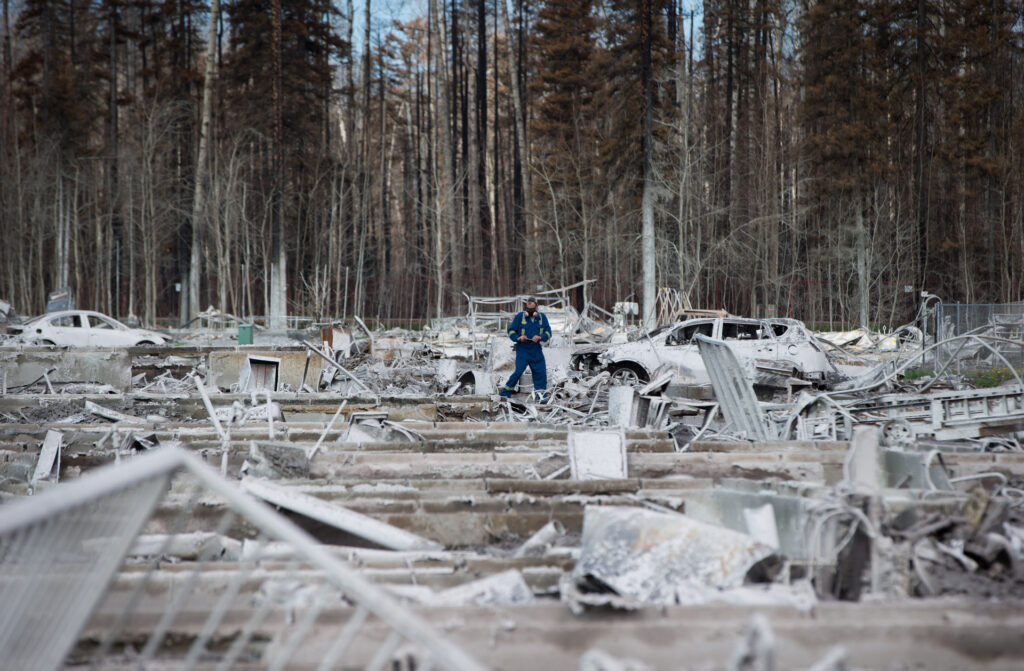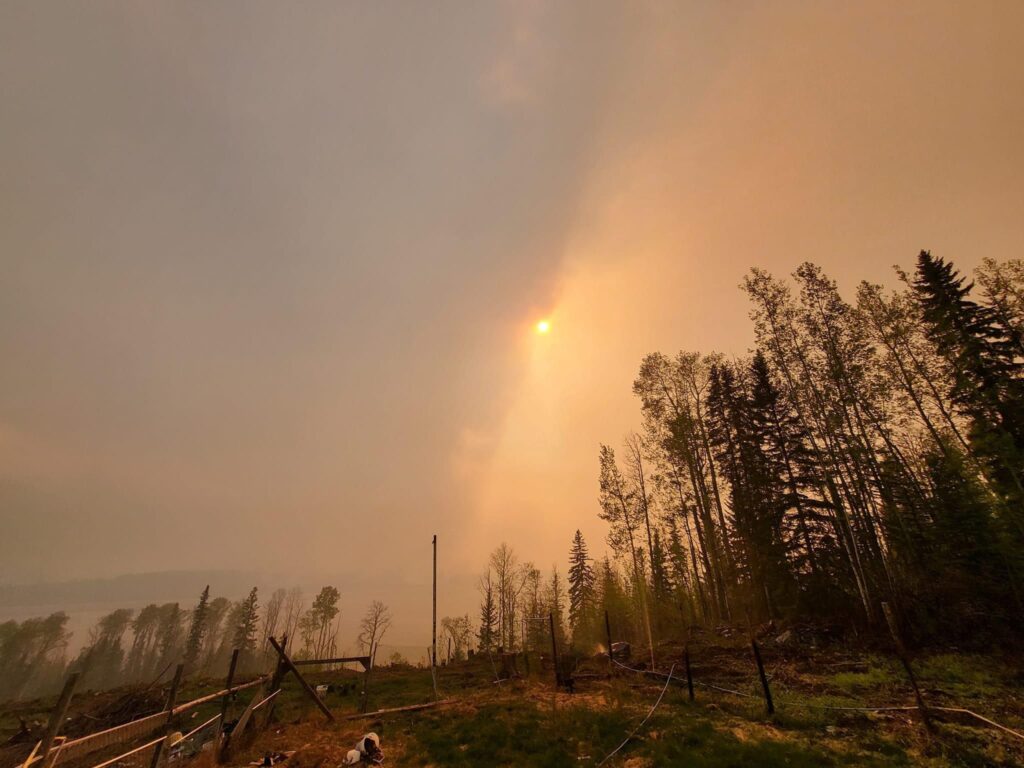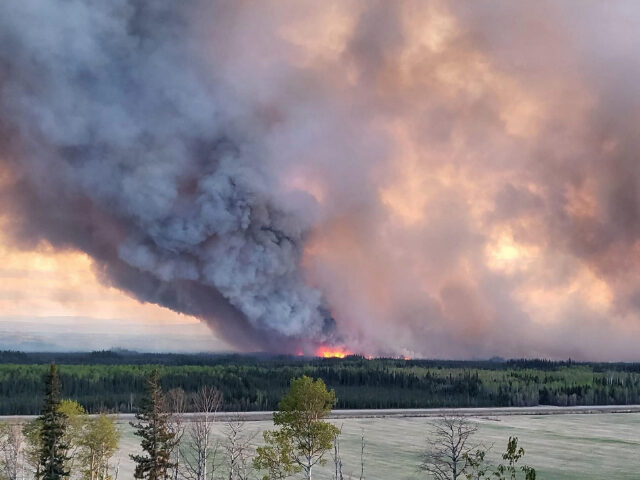Hopes that a favorable turn in the weather might help firefighters contain the massive blaze threatening Canadian oil hub Fort McMurray were dashed on Tuesday, as evacuation orders were issued to about six thousand residents of four southern suburban areas.
The wildfire grew into a major threat in May and began moving toward Fort McMurray, which has a population of about 68,000 and serves as a major logistical hub for Canada’s oil sands industry. More than one million barrels of oil production per day are at risk if wildfires shut down the town.
The winds shifted, and some light rain was spotted in the area, giving fire officials hope that the city might not have to be evacuated, although residents were placed on alert just in case. Fort McMurray was devastated by a wildfire in 2016, so the remote and heavily forested town does not take fire threats lightly.

Resident Dale Pillar takes photographs of the remains of his house, which was destroyed in a wildfire in Fort McMurray, Alberta, Canada, on June 3, 2016. (Darryl Dyck/Bloomberg via Getty Images)
Another shift in the winds might be on the way, but the wildfire grew significantly, resumed its march, and approached within five miles of Fort McMurray’s outskirts, prompting thousands of evacuation notices.
“We’re seeing extreme fire behavior. Smoke columns are developing, and the skies are covered in smoke,” Alberta Wildfire Information Officer Josee St-Onge said on Tuesday.
St-Onge said local winds have increased to almost 25 miles per hour and the fire has grown to over 51,000 acres, making it necessary to pull firefighters back for their safety.
Fire officials said Fort McMurray is much better prepared to handle a massive wildfire than it was in 2016, but many people are reportedly leaving voluntarily in addition to those under evacuation orders.
“People aren’t waiting for an order; they’re just going already. I feel sunk. I’m 71, and I don’t want to go through this again; it’s horrible,” said downtown Fort McMurray resident Elsie Knister on Tuesday.
Shop owner Suzy Gerendi said she was already packed and ready to go when the evacuation order was issued. By Tuesday afternoon, she was already on her way to Edmonton with her dogs.
“It’s very, very dark and orange. It brings up some memories, and it’s not a good feeling,” said Gerendi, who lived through the 2016 fire.
“I think the worst part right now is the unknown — not knowing if we’re going to have a home to go back to,” said evacuee Marina Barnes, who has lived in the Fort McMurray suburb of Abasand for four years.
“I could see the orange glow from my balcony, and where I live in Abasand, it’s the farthest back apartment. So, if the fire were to reach Abasand, my building would have been the first one to get hit,” she said.

Smoke rises after fire erupts in Western Canada on May 14, 2024. (Cheyenne Berreault/Anadolu via Getty Images)
Emergency management director Jody Butz said one advantage for Fort McMurray is that the new fire, designated MWF-017, is trying to creep through the same terrain as the 2016 fire. The earlier fire, known locally as “The Beast,” destroyed a great deal of woodland and construction that has not been replaced, so MWF-017 does not have as much fuel to work with as it covers the same track.
Butz said fearful memories of The Beast are understandable but urged residents not currently under evacuation orders to remain in place, giving those in more imminent danger time and space to clear out.
“Please, please allow these communities to evacuate first. It is important that we approach this in a safe and orderly and respectful manner,” Butz said.
Some of those leaving voluntarily countered that they remembered how quickly the 2016 fire advanced, forcing them to flee in panic with minimal possessions and supplies, terrified children and pets in tow. They said they would rather leave early this time, in a more calm and organized manner.
The MWF-017 fire has not yet affected oil production in the Fort McMurray area, but its southern edge is now within five miles of the Hangingstone well site, which is managed by Athabasca Oil Corp. Three gas and oil pipelines managed by other companies run through the wildfire zone.
Another troubling fire is burning near Fort Nelson, British Columbia, which is close to a major natural gas production zone. Emergency workers are urging the last residents of the small town and nearby First Nations community to evacuate as strong winds bring the enormous fire closer.
“We are extremely concerned. It is extremely uncommon for us to have so many on an evacuation order,” provincial emergency management minister Bowinn Ma said on Monday after more than 4,700 evacuation notices were issued.
Rob Fraser, mayor of the Northern Rockies Regional Municipality, said less than a hundred people remained in Fort Nelson by Tuesday morning. Fraser said fire crews and emergency workers were preparing for a “last stand” to save the town.
Fort Nelson resident Jordan Pust said the evacuation order produced the most traffic he has seen in his eleven years living in the area. He told the Globe and Mail that support from surrounding regions was invaluable to the evacuees, but he feared those helpful neighbors would soon have their own fire crises to deal with.
“What happens when those portions of the province start to have forest fires themselves? Then we’re left standing, watching our community fall apart,” said Pust.

COMMENTS
Please let us know if you're having issues with commenting.